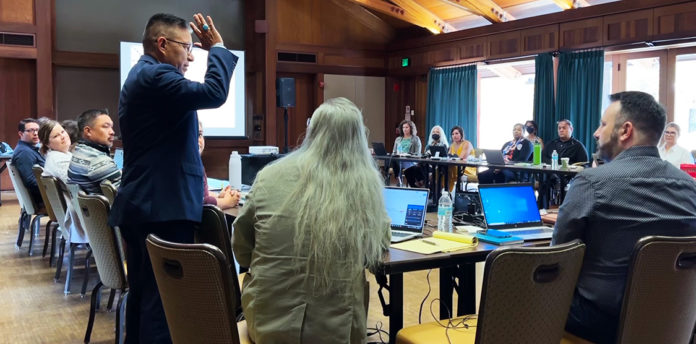PACIFIC GROVE, CA – Navajo Nation Vice President Myron Lizer attended the National Indian Health Board’s (NIHB) 50th year anniversary and strategic planning conference in Pacific Grove, CA, on behalf of Navajo Nation President Jonathan Nez, who is the acting NIHB member for the Navajo Area.
“It’s an honor to be a part of all the distinguished tribal leaders who are developing a fresh vision for Indigenous citizens as we endure this pandemic and carry on our legacy of resilience,” said Vice President Lizer. “I believe we are experiencing an awakening to supreme health care, which the next generation will be able to run with over the next 50 years as we harken to our land and remember our culture. May we continue to pray and utilize the lessons from those who came before us to seek the Creator’s will for our people.”
The conference included approximately 30 other board members and staff from across the country including Portland, Alaska, Nashville, Minnesota and Hawaii. Also in attendance was To’Hajiilee Band of Navajos Albuquerque Area Representative Jacqueline Platero, who shared her perspectives and experiences advocating for the Navajo Nation’s satellite communities.
The focus of the three-day session was to continue strategizing for the tribal public health infrastructure outlook utilizing lessons from the last 50 years and discussing ways to increase tribal representation at the national and international levels.
After an opening prayer was offered by Marie Tribe of Chippewa Indians Chairperson and NIHB Government Relations Director Aaron Payment, NIHB Board Director Stacy Bolan provided a presentation highlighting the board’s accomplishments from the last five years.
Among the most notable efforts was the NIHB’s advocacy, along with the Navajo Nation and other tribes, for the $19.5 billion appropriated by Congress to tribal nations through the American Rescue Plan Act in 2021. Two billion dollars of the funds were allocated to the Navajo Nation for COVID-19 relief, which was recently appropriated for infrastructure, health care priorities, hardship assistance, and many other needs.
Other notable accomplishments for the NIHB include advocating for the preservation of the Special Diabetes Program for Indians and retaining the Center For Disease Control’s Good Health and Wellness in Indian Country investment.
Collaborative break-out workshops were also held to clarify and provide more guidance on initiatives including youth empowerment, defining tribal health equity, and holding federal health entities accountable to trust responsibilities.
“Part of the growth we will see means stepping into our authority as sovereign nations and using our voices to unite as we reclaim tribal identities through our legal rights,” said Lizer. “We will continue to make progress as long as we work together and continue to coordinate these efforts in the long-term.”
Vice President Lizer also thanked the NIHB board members for their outstanding advocacy and dedication to improving the health and wellness, not only for the Navajo People, but all the tribes throughout Indian Country.














































